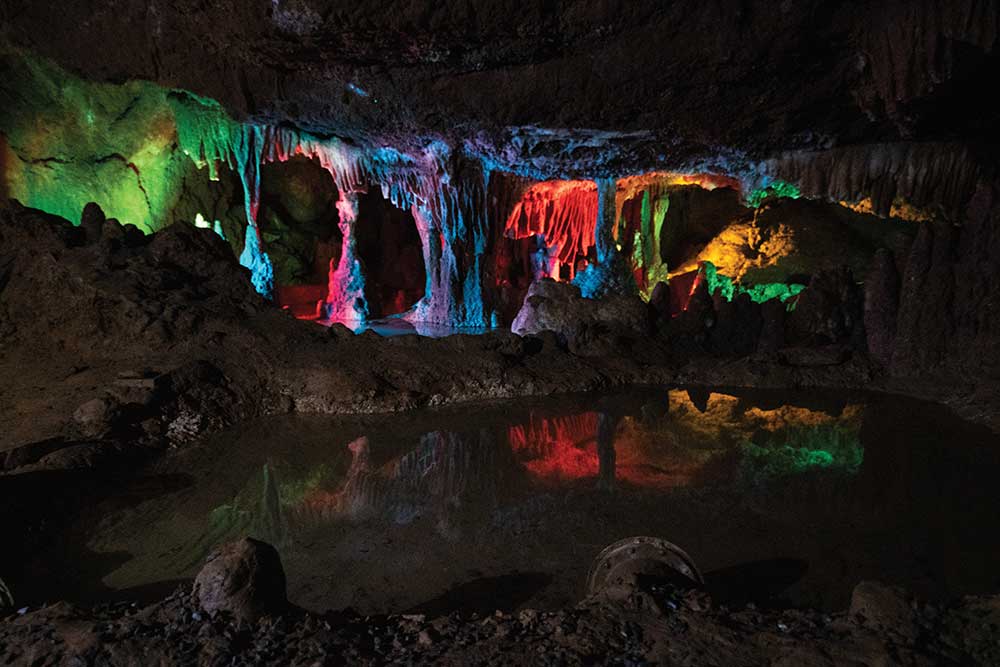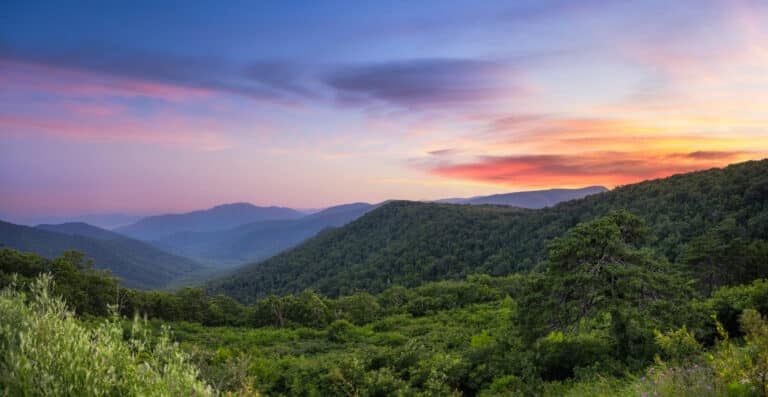The Rainbow Room in Grand Caverns, VA. / Photo by Ellen Kanzinger
What we don’t know about the underground world beneath our feet
When you think about the landscape that defines this region, you probably think about what’s on top—the three-quarters of the Appalachian Mountains reaching into the sky; rivers and streams flowing across the terrain; and the vegetation coloring the view.
But beneath our feet, a karst landscape created by dissolving carbonate bedrock remains relatively hidden to the untrained eye and under-protected. Characterized by caves, sinkholes, sinking streams, and springs, this landscape is an especially sensitive environment.
This delicacy is apparent as I make my way into Madison Cave. Wil Orndorff, the Karst Protection Coordinator for the Virginia Department of Conservation and Recreation, reminds the group to watch their step so as to not disturb the formations, many of which have been growing for centuries.
He leads us towards the back of the cave to a lake, home of the Madison Cave Isopod.
“Many of Virginia’s rare animals are associated with cave and karst landscapes,” Orndorff said. “We have nearly 200 cave-limited species. About half of those are known from five or fewer locations.”
The Madison Cave Isopod, listed as a threatened species since 1982, is one of them. This freshwater crustacean has only been found within karst waters in and around the Shenandoah Valley.
“In most cases, especially for the invertebrate fauna, the cave is this really small window into this huge underground wilderness,” Orndorff said.
Researchers are just scratching the surface in discovering the vast ecosystems within these karst landscapes.
Dr. Daniel Doctor, a research geologist with the U.S. Geological Survey, specializes in mapping the karst landscape in the Appalachians.
“Every cave has developed its own ecosystem over time, generally geologic time,” he said. “We as humans may not be aware of the great variety of organisms that exist, that are microscopic.”
But underground water sources are more than a home for these species, invisible to the human eye. Karst plays an important role in the health of our groundwater and water supply.
“For a long time, people have been viewing holes in the ground as a convenient place to put waste, whether it’s household waste or some other kind of trash,” Doctor said. “A lot of people don’t realize that if they put trash into a sinkhole that may be somewhere on their property, they may actually be harming the quality of their own water supply. Those voids that are in the subsurface that caused that sinkhole to be there in the first place are likely connected to other voids that may be feeding water to a well. The larger they are, they tend to be more connected.”
What happens on the surface can eventually make its way into a water supply. Water entering a sinkhole or cave avoids natural filtration through soil, making it easier for contaminants to remain in the water supply as underground streams and aquifers feed wells and springs used for local water supplies.
These water supplies are much more vulnerable to soil erosion, heavy runoff, high-density development, and land disturbances.
“People have a bad habit of looking at spring water and well water as this magical resource,” Orndorff said. “From science, we know that it’s not. It’s water that landed somewhere as precipitation, typically not very long ago. On its way to your well, it picked up chemicals, dirt, microbes. So, water is directly affected by the land use activities. In limestone or karst areas, that impact is probably more pronounced than a lot of other landscapes just because of the nature of caves and karst.”
Another problem? These cave systems are not recognized as waterways. Meaning they are not regulated as strictly as other sources of drinking water, like rivers and lakes.
“Where a person could not discharge a bunch of sediment into a stream, if it goes into a sinkhole, it falls through the gaps,” Orndorff said.
Until states and agencies are able to come up with better protections for these landscape features, the best protection for these sensitive ecosystems is informed residents.
“I think the main thing we need to do is educate people, let them understand that this is not Disneyland,” Doctor said. “This is an ecosystem. This is a natural place that you want to treat with some respect.”
Understanding Our Past
In studying the formations within caves, Dr. Daniel Doctor and other researchers are able to take a peek inside Earth’s history on a geological time scale.
“Because they grow at slow rates and they record some of the chemistry of the water that they precipitate from, we can use that as a proxy or indirect indication of the changes above the cave in terms of long-term climate,” Doctor said.
Speleothems, like stalactites and stalagmites, form over thousands of years as water drips down from the ceiling or pools on the floor. To understand what was happening above ground during those millennia, researchers cut the formations in half to look at the layering.
“Then, we drill down layer by layer, sample all the layers continuously, and analyze the chemical and isotopic composition of the mineral calcite,” Doctor said. “Periodically, we will sample out an entire layer and get a radiometric age dated using the uranium thorium age dating method. That gives us the time scale on which these changes occurred.”
After measuring the oxygen and carbon isotopes, researchers are able to calculate climate conditions such as air temperature and precipitation levels. Samples dating back thousands of years from caves like Grand Caverns in Virginia can then be compared to samples from around the world for similarities.
“Climate changes that have been recorded in ice cores from Greenland and stalagmites from other caves on the opposite side of the world in China, they show very similar patterns to what we see here in Virginia,” Doctor said. “It just confirms the fact that these stalagmites are very useful indicators of recording past climate changes going back tens of thousands of years. Some of these changes are global in nature and we can see them on different continents across the globe.”








